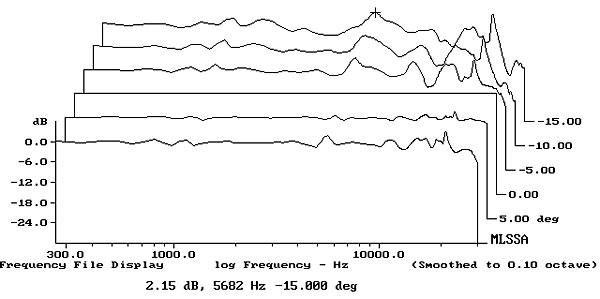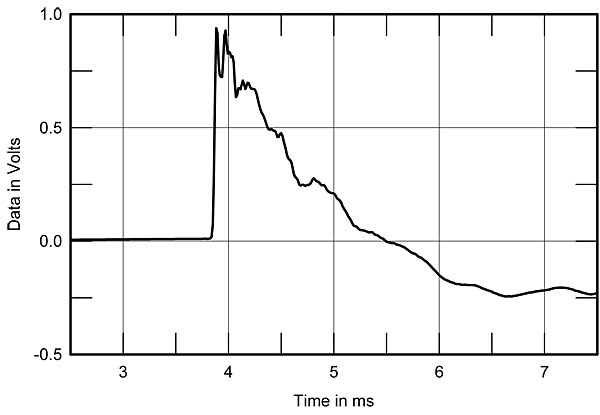| Columns Retired Columns & Blogs |
Very classy with the darker wood and the screen taken off!
http://jeremyrea.blogspot.com/
I measured the Thiel SCS4T's frequency response in the farfield with DRA Labs' MLSSA system and a calibrated DPA 4006 microphone. For the nearfield and room responses I used an Earthworks QTC-40, which has a small enough diameter not to interfere with the flow of air in the speaker's reflex ports.
The SCS4T's sensitivity was slightly above average, at an estimated 89dB(B)/2.83V/m, which is higher than the specified 87dB. Its electrical impedance is shown in fig.1. As is typical for a Thiel design, the impedance is relatively low, ranging between 3 and 5.8 ohms for almost the entire audioband. The electrical phase angle is low, however; the SCS4T won't give a good 4 ohm–rated amplifier any difficulty.

There is a wrinkle in the impedance traces around 1500Hz, which usually indicates some kind of resonance at that frequency. However, when I examined the vibrational behavior of the enclosure's panels, I found a series of strong resonances at lower frequencies on all surfaces. Fig.2, for example, is a cumulative spectral-decay plot taken from the output of an accelerometer fastened to a sidewall adjacent to the coaxial drive-unit. Strong modes are present at 664, 863, and 1027Hz, with some lower-level modes present between 1 and 2kHz. While only the higher-frequency modes were present on the front baffle, and then lower in level, the 664Hz mode was very high in level on the plastic service panel on the SCS4T's rear. However, the lower half of the enclosure, which basically serves as a stand, was much less resonant. In general, the higher the frequency of resonant modes and the higher their Quality Factor (Q), the more subtle will be their effect on music. But the behavior of the SCS4T's cabinet does alarm me, and I suspect it had something to do with the indistinct quality Erick Lichte noted. In my own listening, I found that piano notes sounded uneven in the upper midrange, and rich piano chords took on a somewhat congested character.

The saddle centered on 48Hz in the impedance-magnitude trace suggests that this is the tuning frequency of the twin reflex ports. However, as shown by the blue trace in fig.3, the woofer's minimum-motion frequency—ie, the frequency at which the cone is held stationary by the back pressure from the port resonance—is a little lower, at 42Hz. The output of the ports (red trace) peaks between 40 and 60Hz, with a smooth rolloff above that region. The black trace below 300Hz in fig.3 shows the complex sum of the woofer and port outputs, taking acoustic phase into account, and rolls off with the usual 24dB/octave slope below the port tuning frequency. What is not seen in this graph, however, is the 6dB boost in the upper bass that results from the nearfield measurement technique, which assumes that the drive-unit is fixed in the center of a true infinite baffle; ie, one that extends to infinity in all directions. The Thiel would appear to have an overdamped bass alignment, which ties in with EL's finding its balance to be on the lean side. However, this will optimize the SCS4T's integration with a subwoofer.

The black trace above 300Hz in fig.3 shows the SCS4T's farfield response averaged across a 30° horizontal window centered on the tweeter axis, without the grille. The overall trend is flat, with small response dips balanced by small peaks. This response is that of the sample with serial no.42. The other sample of the pair, no.41, was about 1dB less sensitive in the region covered by the tweeter, with a slightly deeper suckout between 5 and 6kHz (not shown).
Whether or not the SCS4T's treble balance will be perceived as flat will also depend on its horizontal dispersion, which is shown in fig.4. The pattern below 2kHz is wide and even, but the woofer's output does narrow a little before it crosses over to the tweeter, which has a wide dispersion up to 10kHz or so. Though there is a ridge of off-axis energy between 5 and 6kHz, which will give rise to an excess of energy in the reverberant field in this region, this is where the on-axis response has a slight suckout; it's possible that the perceived balance will be neutral, at least in rooms of normal size. The tweeter's off-axis behavior in the top two octaves is complex, due presumably to the drive-unit being sited in the center of the woofer cone. In the vertical plane (fig.5), the dispersion is not as symmetrical as I was expecting, given the symmetrical nature of the coaxial array. Again, the on-axis suckout between 5 and 6kHz fills in as the listener moves above the tweeter axis.


I set up the Thiels in my own room, driving them with Musical Fidelity's AMS-100 class-A amplifier. The red trace in fig.6 shows the spatially averaged, 1/6-octave response of the SCS4Ts in my listening room, the blue trace the response of the Rogers LS3/5As measured in identical circumstances. Both speakers have flat, neutrally balanced high frequencies, although, as I've written before, the LS3/5A's treble is a little too hot in absolute terms. Each speaker has a small peak in its response around 1200Hz, but the Thiel also has a second peak, between 500Hz and 1kHz. It's possible that it is this peak that led EL to find the SCS4T's sound a bit nasal. Alternatively, and depending on the music being played, if the level of the peak is taken as a reference point, then the regions to either side would sound a little deficient in energy, which perhaps correlates with EL's finding the SCS4T's midrange to be "on the laid-back, relaxed side of things." In the bass, while the Thiel does extend lower than the miniature LS3/5A, and thus excites the 63Hz resonance in my room more than that British speaker, the slower, sealed-box rolloff of the LS3/5A gives it more midbass energy in-room than the American speaker.

Thiel speakers have always offered time-coherent outputs, and the SCS4T is no exception. Fig.7 shows its step response on the tweeter axis. It is almost a perfect right-triangle shape, with a sharp initial rise and a uniform decay, though some reflections can be seen up to 2ms after the initial arrival of the sound at the microphone. The SCS4T's cumulative spectral-decay plot (fig.8) indicates that the small peaks in the treble are associated with some ridges of delayed energy, though the time-coherent nature of its output gives rise to a clean initial decay overall.


The Thiel SCS4T offered a basically flat on-axis response, but I was concerned about its lively enclosure and that excess of in-room energy between 500Hz and 1kHz; the latter will be emphasized by the overdamped bass alignment. Both of these factors worked against the speaker sounding as clean or as accurate as I was expecting, though it's fair to note that the more-expensive Audience ClairAudient 2+2, reviewed elsewhere in this issue, suffered from similar problems.—John Atkinson

Very classy with the darker wood and the screen taken off!
http://jeremyrea.blogspot.com/